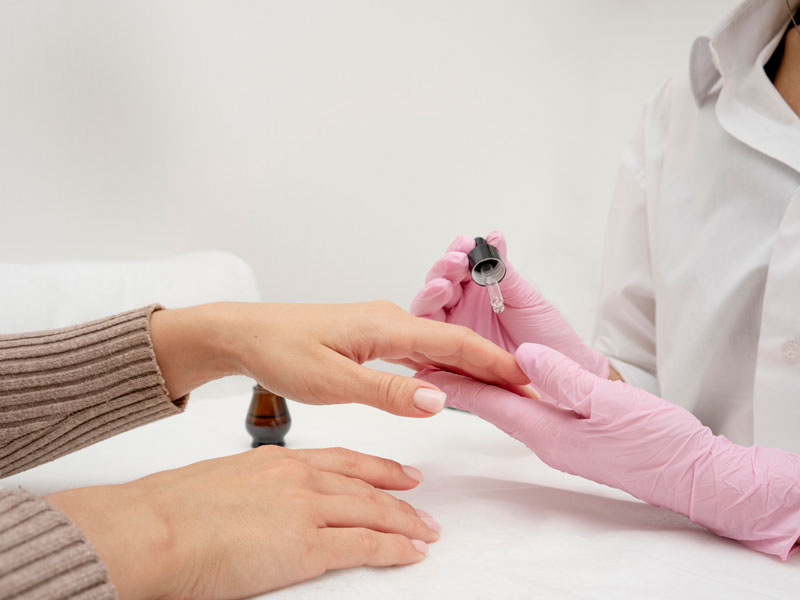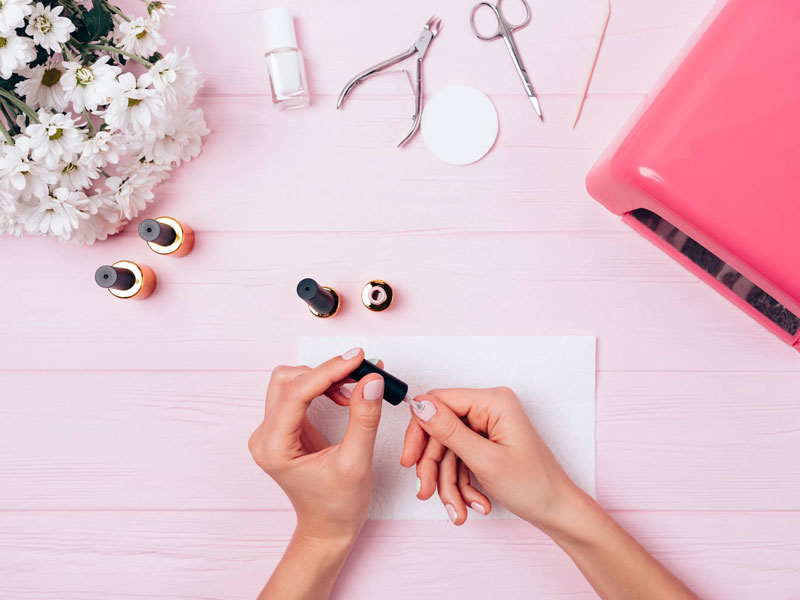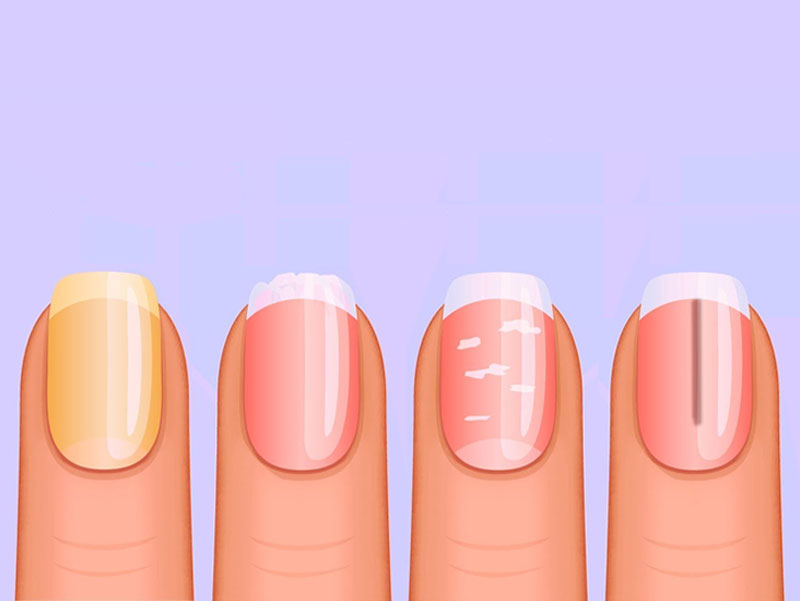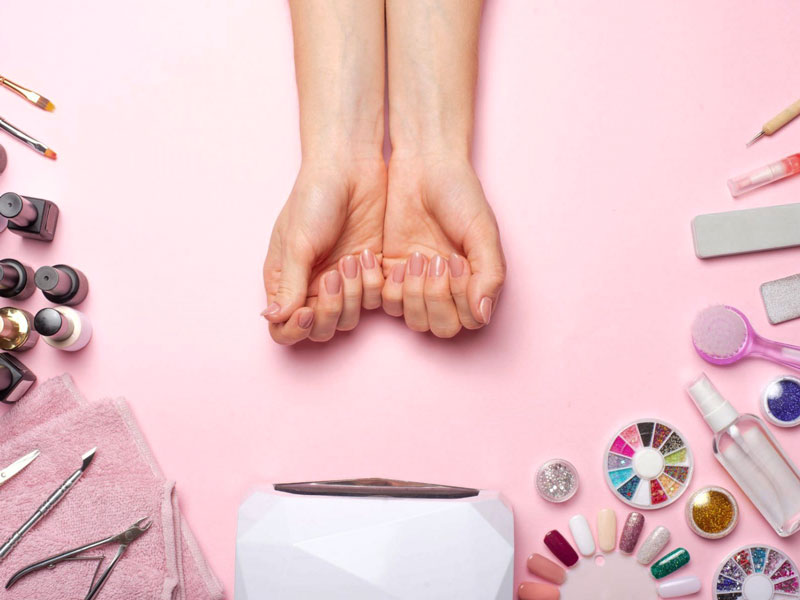Nail care and having clean, healthy-looking nails are essential for practicing good hygiene and looking your best! However, nails can be easily damaged due to a poor manicure or the normal wear and tear of life. You can keep your nails strong and well-maintained by taking care of your nails by following a few simple habits.
Before looking for a nail care routine and getting started with nail care products, it is best to educate yourself on nail structure. The most essential way to keep your nails healthy is through better understanding your nail component routine and consistent daily steps to taking care of your nails.

In short, nails are made up of laminated layers of keratin, a protein found in your hair and skin. Each nail is made up of several parts, including:
- The nail plate: The nail’s visible hard part.
- Nail folds: The skin that surrounds the nail plates on three sides.
- The nail bed: The layer of skin beneath the nail plate. The cells at the base of the nail bed are responsible for the formation of the fingernail or toenail plate.
- The cuticle: The tissue at the base of your nail that overlaps your nail plate. It shields the new keratin cells that emerge from the nail bed gradually. The matrix is the area beneath the cuticle.
- The lunula: The whitish, half-moon shape at the base of your nail beneath the plate.
Signs of healthy nails
Most nail changes aren’t serious, but some may indicate that you’re deficient in certain vitamins or minerals. Some of the more serious conditions that your nails can reveal are heart, lung, and thyroid disease. To spot these signs, you must first understand what healthy nails look like and what changes indicate that something is wrong.
Healthy fingernails are smooth, without pits or grooves, and free of discoloration or spots. Fingernails can develop harmless vertical ridges running from the cuticle to the tip of the nail. Vertical ridges become more visible with age.
Due to injury, the nail may develop white lines or spots, but these will eventually fade away with the nail. It is crucial to note that sometimes the vertical lines associated with the nails are due to underlying skin cancer, especially melanoma. It is very important to consult a dermatologist if you notice vertical lines affecting your nails.
Daily nail care routine
Having a nail care routine may not seem important, but it is just as essential as washing your hair and taking a bath/shower. Here are some simple steps to an effective nail care routine:
- Use soap and warm water to clean your hands.
This will clean your nails, stop the growth of bacteria on your hands, and possibly stop the worsening of the dirt under your nails. After thoroughly rinsing off the soap, dry your hands with a soft, clean towel. Also, it is recommended that you soak your nails in warm water every two weeks or so.
When cleaning under your nails, use a clean, soft nail brush to avoid transferring dirt and skin cells back under your nails. Your nails are delicate, and scrubbing them too vigorously can cause trauma to your skin which can be a portal for entry of bacterial or other types of infection.
- Trim only soft nails
Once you’ve washed your hands with warm water, trim your nails. The more often you trim them (before they get too long), the stronger they will turn out to be. It is easier to trim your nails after a bath/shower since they are soft and gentler to clip.
Keep in mind that if you file your nails immediately after being exposed to water, you risk weakening them.
- Apply hand lotion or cream
Using a hand lotion/cream will help to moisturize your skin in addition to the natural moisture provided by your body. Make a habit of rubbing some into and around your nails. This will not only soften your hands, but it will also benefit your fingernails and cuticles.
- Apply Cuticle Oil
Using a cuticle moisturizer is beneficial to your nails, resulting in healthier and stronger nails. Apply a small amount of oil to and around your cuticles, making sure to cover the skin around your nails as well. You can also soak your fingertips for a few minutes in a small bowl of oil.
- Avoid biting/picking your nails
Biting/picking can cause inflammation around the nail, interfering with its healthy growth. Before you blame your nail fragility on other factors, make sure you’re not using your fingernails for things they shouldn’t be used for.
- Diet
A healthy, well-balanced diet is essential for your nails as well as the rest of your body. Make sure your diet contains the vitamins and minerals listed below to keep your nails strong:
- The most important ingredient for nail health is biotin, also known as vitamin B7. It protects against brittleness and promotes growth.
- Omega 3 fatty acids, particularly those found in fish oil, strengthen and shine the nails.
- Vitamin A provides support.
- Vitamin B12 and B9 deficiency cause blue and streaked nails.
- Vitamin C is an essential component of nails.
- Iron promotes nail health and helps to prevent ridges along the nails.
- Magnesium greatly helps in the prevention of nail ridges, as well as protein synthesis and the formation of new nails.
- Zinc is required for nail cell replication and hair growth.
How to Clean Your Nails and Toenails
Dirt, grease, and even paint can all become trapped beneath your nails. Regular hand washing, nail clipping, and scrubbing under the nails help remove dirt and grease. As the first step in nail care, here are some tips on how to clean your nails and toenails.
- Wash your hands and feet with soap and warm water. To thoroughly clean your hands, feet, and nails, use hand soap. These soaps are designed to cut grease and are frequently effective in reducing grease and oil buildup under the nails.
- Use hand soap made for your needs. Consider investing in a cleanser designed to get grease and dirt off of your hands.
- Keep your fingers and toes dry. Use a soft washcloth to get under your fingernails and around your cuticles—those hard-to-reach places. Always wash your washcloth after each use.
- Wash your nails with lukewarm water. Never use hot or cold water; only warm water. Compared to extremely hot water, lukewarm water is less drying to the hands and nails.
- Make use of an orange stick. These angled, pointed wooden sticks, also known as cuticle sticks, are one method for manually removing dirt under your nails.
To avoid overdrying, always apply lotion to your hands and nails after cleaning. Petroleum jelly is a common household item that can aid in the maintenance of healthy nails. Lotions containing glycerin can be applied for moisture retention.
Nail care products
In addition to what we’ve discussed so far about nail care at home, you can always use some nail care products on your nails to keep them healthy. To nourish and maintain healthy nail beds, incorporate cuticle oil, cream, or lotion into your routine. Then apply a hydrating hand cream to finish the job.

Below, you can find all of the nail care products you need to treat your nails at home:
- Hand scrub
Using a hand scrub, you can keep your hands looking young and smooth. They’re an excellent way to remove dead skin cells while also keeping your hands soft and ready for hand-holding or handshaking.
- Cuticle Cream
Cuticle Cream keeps your cuticles supple. Softens the skin around the nail, allowing it to be separated from the nail plate and gently rolled back. This product also gives the nails a well-groomed contour.
- Hand Cream
Hand cream is a specialized formulation that is designed to nourish and protect the skin on the hands and nails. A good hand cream will soften and moisturize your hands and nails and will also repair and reverse the effects of neglect on your hands.
- Cuticle Oil
Applying cuticle oil to your nails can improve circulation and stimulate nail growth. It can also protect your nail and cuticle from trauma. The oil can also help your nail’s health and appearance. If you paint your nails, cuticle oil can help your polish last longer.
- Nail Strengthening Polish
Nail strengtheners improve the health of the natural nail plate by protecting and nourishing the nails. The strengthener acts as a protective, flexible film that reinforces the nail structure while also providing vitamins and nutrients to the nail plate to promote growth.
- Base coat
Darker polishes can stain your nails and cause them to turn a yellowish color. While every person is different, this reaction can occur within days or weeks of wearing the nail color. Always use a base coat before polishing your nails to keep them from yellowing.
Facts and myths about nail care
The self-care industry is large, and many people enjoy pampering themselves at home. While our fingernails and toes can reveal a lot about our health, not every white spot on them indicates a problem. Here are some nail care myths and facts to help you sort through the confusion and take better care of your nails.
- Myth: Gelatin and polishes containing hardener will make your nails stronger
Although some people firmly believe that soaking their nails in gelatin makes them stronger, this theory is not supported by any scientific data. On the other hand, while using polishes with strengthening ingredients may help to reduce the likelihood of nails splitting, they also increase nail stiffness, making the nails more likely to break when subjected to trauma.
Maintaining moisture in the nails is the best way to ensure their strength. Since the majority of nail polish removers contain alcohol, it is crucial to moisturize afterward. Moreover, daily life puts a lot of stress on nails, and they are frequently exposed to harsh chemicals and detergents that can dry them out. Dermatologists recommend mineral oil or petrolatum-based moisturizers because they are particularly effective at preventing evaporation. keep in mind that as the majority of hand creams contain these ingredients, no special products are required.
- Myth: Pushing back cuticles will improve nail growth.
The cuticle acts as a barrier between the skin and the delicate nail matrix or ‘root’ of the nail. Pushing back on the cuticle can cause it to become infected and expose the paronychium, or skin fold around the nail, to bacteria. The majority of people groom their nails by pushing them back, but dermatologists advise against doing so because it can cause problems.
- Myth: Your nails need to breathe.
As most of our nail plates are dead, it doesn’t make sense for them to breathe. Nails do not require to breathe, they get their nutrients, oxygen, and blood supply from the bloodstream, not from the air. Allowing the nails to breathe is a term used by nail specialists to describe taking a break from nail polish and polish remover to allow dry, brittle, peeling, or damaged nails to heal.
Signs and symptoms of unhealthy nails
Having ridges in your nails, having nails that break easily, and having discolored nails are all telltale signs that your nails are unhealthy. The American Association of Dermatology (AAD) states that smoking or nail polish can cause yellow discoloration. However, in severe cases, lung disease or rheumatoid arthritis may be to blame for thick, yellow nails that have stopped growing.

A greenish-black discoloration on your nails could be a sign of a bacterial infection. A dark black streak on the nail can be a precursor to skin cancer. To fully understand the cause of any discoloration on the nails, the American Academy of Dermatologists (AAD) recommends scheduling an appointment with a dermatologist as soon as you witness discoloration in the nails.
Grooves, pitting, and nail clubbing are other visible signs of unhealthy nails. Deep grooves are divots in the nail bed, and nail pitting looks like someone poked your nails with a toothpick. Nail clubbing is the appearance of curved nails, which can enlarge the fingertips and sometimes indicate lung problems. Grooves in the nails aren’t usually a cause for concern, but they can indicate that something has slowed (or stopped) your nails from growing for a while, according to AAD. However, nail pitting is common in psoriasis patients, which can also cause nail splitting (another sign of unhealthy nails).
Another indication that the nails are unhealthy is if they are getting thinner or thicker. An iron deficiency may be the cause of the nails becoming so thin that they start to dip in the middle and take on the shape of a spoon.
| Nail Problem | Cause | Treatment |
| Yellow tint | Fungal infectionReaction to products | Baking sodaPrescribed Antifungal medicine |
| White spots | InjuriesInfectionsAllergic reactionsMineral deficiencies | Allow time for the nail to grow outAvoid using nail polishConsult with a dermatologist |
| No half moons | No causes | Consult a dermatologist if your symptoms are accompanied by weight changes, dizziness, mood swings, or other unexplained symptoms. |
| Brittle nails | Wetting and drying frequently | Use lotions containing lanolin or alpha hydroxy acid. |
| Soft or weak nails | Excessive exposure to chemicals or moisturePossibly connected to a lack of fatty acids, calcium, iron, or B vitamins. | Maintain natural, unpolished nails; consider taking a multivitamin that contains B vitamins and calcium. |
When to see a doctor for my nails?
If you’ve noticed changes in your nails, you shouldn’t ignore them. Some color, texture, or shape changes are harmless, while others indicate an underlying illness. Some nail problems require the urgent attention of a dermatologist. If you notice any out-of-the-ordinary changes in your nails, make an appointment with a dermatologist as soon as possible. However, below are some of the urgent cases:
Dark streak on your nails
A dermatologist should be consulted if a fingernail or toe has a new or changing dark streak. That dark streak could be melanoma, the deadliest form of skin cancer. Early detection and treatment may be all that is required. Treatment becomes more difficult as the dark streak grows.
Medical name: Acral lentiginous melanoma
Redness or swelling
Nail infection can cause redness or swell around the nail. If this is the case, you’ll want to get it diagnosed as soon as possible so that it can be treated effectively. If it becomes an open sore, it may require more extensive treatment.
Medical name: Paronychia
Pitted nails
Pits in the nails could indicate psoriasis, atopic dermatitis, or alopecia areata. Dermatologists are the medical professionals who diagnose and treat these conditions. Treatment can make you feel better and keep the disease from progressing. If you have icepick dents in your nails, this could indicate that you have a disease that affects your entire body.
Medical name: Pitting
Nail lifting up
An infection, injury, fungus, or an aggressive manicure may cause a nail to lift. A dermatologist should examine any lifting nails and advise you on how to straighten them. A nail doctor can also provide you with some pointers to help the new nail grow normally.
Medical name: Onycholysis
Final Thoughts
Nail care is frequently overlooked as an important part of self-care, but it is critical for your overall health. Maintaining your nails can help you avoid infections and other health issues. Having nice nails can boost your confidence and make you feel put together. Feeling good about yourself reflects on your attitude and interactions with others. Although there are some do-it-yourself tips for keeping them healthy and strong, professional treatments to take care of your nails are sometimes necessary.

6 comments
I have noticed that my nails have become thin and brittle recently. Do you have any suggestions for how I can improve their strength and thickness?
Hello Anna! To improve the strength and thickness of your nails, you can try using a nail strengthener or hardener. You can also try using a nail growth serum, which can help to stimulate nail growth and make them thicker. Additionally, you can try taking biotin supplements, which can help to strengthen and improve the overall health of your nails. It is also important to handle your nails gently and avoid biting or picking at them.
Thanks for the article, I have always been a bit nervous about getting manicures because I am worried about the risk of infection.any tips for how to reduce the risk of infection when getting a manicure?
Thank you for reading, Elizabeth! To reduce the risk of infection when getting a manicure, choose a reputable salon that follows proper hygiene practices, ask about their sterilization procedures, and bring your own nail polish and other personal grooming tools. Use disposable implements whenever possible.
Hello. Any recommendations for nail care products that are safe to use during pregnancy?
Hi Lina, we would be really happy to help. During pregnancy, avoid nail care products with harsh chemicals (e.g. formaldehyde, toluene) and acrylics/UV resins. Ask your healthcare provider for safe product recommendations.